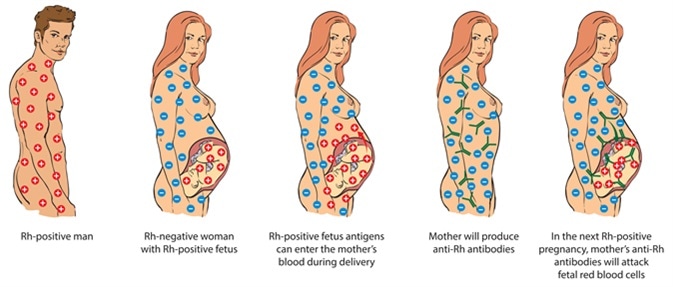The Rh blood group is considered to be one of the more complex types of blood groups in humans and it is secondary to the ABO blood group in transfusion medicine. It was discovered 60 years ago and named after the Rhesus monkey. The polymorphic genes that encode the antigens in the Rh blood group are at a higher level, which explains the reason for its complexity.
Objectives of Antigens in Rh
The RHD gene and RHCE gene are closely linked and a wide range of Rh antigens that are encoded by the hybrid Rh genes are produced by various genetic rearrangements. There have been almost 49 Rh antigens identified until today, among which D, C, E, c, and e are the most significant. The presence of high immunogenic in Rh antigens affects the importance of the Rh blood group type.
When the D antigen appears in transfused or fetal RBCs, nonproduction of D antigen leads to the production of anti-D. For this reason, the Rh status of an individual is routinely determined with blood test in individuals who are donating blood, receiving a blood transfusion, or pregnant.
The RH antigen specificity is determined by the sequence of the amino acids. A part of the protein complex in the membrane of the RBC is expressed as Rh antigens. Due to the expression of complex erythroid line cells, the Rh antigens are expressed only in the RBCs.
The reason for this complex composition is unknown, but it is assumed to be a tetramer. This contains two molecules of Rh proteins and two molecules of Rh associated glycoprotein (RhAG). Either of RhD or of RhCE can be the Rh proteins, where RhD carries the D antigen and RhCE carries the C/C and E/e antigens. The presence of both RhCE and RhD in a single complex is still unknown, but in D negative individuals the complex would contain only RhCE.
Blood 5, Blood groups, Rhesus factor
Proteins in Rh System
It is assumed that the Rh antigens play an important role in maintaining the integrity of the RBC membrane, which lacks the abnormally shaped Rh antigens. Deletion of RhAG causes the rare Rhnull phenotype in individuals. Such individuals may have RBCs that show no Rh antigens due to its unfeasibility in getting targeted to the RBC membrane.
The absence of Rh complex leads to a shorter lifespan, alterations in RBC shape, and an increase in osmotic fragility, all of which contributes to very mild hemolytic anemia. Antibodies against many Rh antigens are developed in patients during the adverse transfusion reactions, which may be critical to the patients.
It is important to note the fact that the blood group proteins are found with the first member of a family of urea transporters and the first member of a family of water channels that are aquaporins, which are Kidd and Colton blood groups, respectively.
Persistence of Rh Antigens
The occurrence of D antigen is 92% in dark skinned people, 85% in Caucasians, and 99% in Asians.
The frequency of C antigen is found 68% in Caucasians, 27% in dark skinned people, and 93% in Asians.
The E antigen is found 22% in people of dark skin, 39% in Asians, and 29% in Caucasians.
The C antigen is found 80% in Caucasians, 47% in Asians, and 96% in dark skinned people.
On the other hand, the E antigen is found 98% in people of dark skin and Caucasians and 96% in Asians.

Rh-factor - Image Credit: NoPainNoGain / Shutterstock
Persistence of Rh Phenotype
The Rh haplotype Dce can be found mostly in dark skinned people with an incidence of 44%. The deletion of the RHD gene results in Rh D-negative phenotype in 15% of Caucasians. Rh D-negative is found in 8% of Africans show up the Rh D-phenotype that are increased by three molecular backgrounds.
One such background is the deletion of RHD gene, which is common among Caucasians. The other two mechanisms are inheritance of the RHD pseudogene or RHD hybrid gene. The premature stop codon introduced by the duplication of nucleotides is found in the RHD pseudogene. The RHD hybrid gene contains RHCE gene sequencing nucleotide.
DCe, a Rh haplotype, is commonly found in Caucasians with 42%, in Native Americans with 44%, and Asians with 70%. Rh D-negative phenotype can be found very rarely in Asians with just 1%, and about 8% with dark skinned people and with higher frequency of 15% in Caucasians.
Production of antibodies against Rh antigens
- Antibody type (IgG, IgM): The IgG type mainly contains most of the Rh antibodies.
- Antibody reactivate: The activation of complement is done very rarely by the Rh antibodies. The Rh antibodies are blinded to the RBCs and they also mark them for destruction by the spleen called extra-vascular hemolysis. This type is capable of hemolysis.
- Transfusion reaction: Antibodies such as anti-D, anti-C, anti-e, and anti-c can cause extra-vascular hemolytic transfusion reactions, which are often delayed.
- Hemolytic disease in newborns: This accounts for 50% of the maternal alloimmunization by the D antigens, making it the most common cause. The anti-D and anti-c antibodies can contribute to causing several diseases and anti-C, anti-E, and anti-e may cause diseases ranging from mild to moderate in severity.
Further Reading